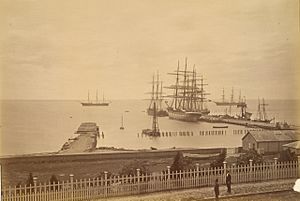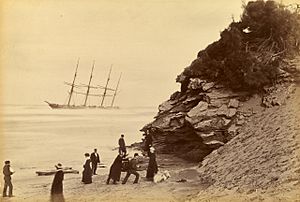Fred Kruger facts for kids
Fred Kruger was a famous photographer who was born in Germany. His full name was Johan Friedrich Carl Kruger. He lived from 1831 to 1888. Fred Kruger became well-known for his early photos of beautiful landscapes and the Aboriginal people in Victoria, Australia.
Contents
Moving to Australia
Fred Kruger was born on April 18, 1831, in Berlin, Germany. His family was working-class. Before becoming a photographer, he worked as an upholsterer, making and repairing furniture. In 1858, he married Auguste Wilhelmine Elisabeth Bauman in Berlin.
Fred Kruger moved to Australia first. His wife and son are thought to have followed him to Victoria, Australia, in 1863. When he first arrived, he joined a furniture business. His brother, Bernard, had started this business in a place called Rutherglen. Fred later owned the business by himself. But he sold it before 1866. After that, he worked as a cabinetmaker in Taradale.
Becoming a Photographer
In 1866, Fred Kruger started his own photography business. His first studio was in Carlton, Melbourne. He moved his studio several times over the years. He had studios in Prahran and Preston, both suburbs of Melbourne.
During this time, Fred Kruger's photos started to get noticed around the world. He won medals at big exhibitions. These included the Vienna Exhibition in 1872 and the Philadelphia Centennial Exhibition in 1876.
Famous Photos and Projects
Fred Kruger was the first photographer to take group pictures of the first Aboriginal cricket team. This was in 1866. One of these photos became very famous.
Later, in 1877, the Aboriginal Protection Board asked him to take more photos. He created a collection of portraits of Aboriginal people living at the Coranderrk reserve. This was a special area run by the government of Victoria. These important photos were shown to the public in 1883.
Fred Kruger kept winning awards for his work. In 1879, he won a gold medal for his landscape photos. He also won an award for a panoramic view of Geelong at an exhibition there. He was known for taking detailed photos of groups of people, making sure everyone could be seen clearly.
Life in Geelong
Fred Kruger eventually settled down in Geelong for good. His photography studio was registered in Newtown, a suburb of Geelong, in 1887. In 1880, he created a collection of twelve photos showing the streets and buildings of Geelong. This work won him another award at the Melbourne International Exhibition (1880).
The government of Victoria also hired him for special projects. He photographed the Yan Yean Waterworks for an exhibition in London. Rich house owners also asked him to photograph their homes. One of his most famous clients was Lady Loch, the wife of the Governor of Victoria.
Fred Kruger also visited the Queenscliff area three times. He went in 1881, 1882, and 1885. There, he took pictures of the town's buildings and its beautiful seaside setting.
Fred Kruger passed away on February 15, 1888. He died from an illness called peritonitis, which is an inflammation in the stomach area. Many of his amazing photos are now kept and shown at the National Gallery of Victoria.
Exhibitions and Legacy
Fred Kruger's photographs have been shown all over the world. One of his most famous works is the first group photo of the Aboriginal cricket team, taken in 1866. It was called "Aboriginal Cricketers of Coranderrk." He also took portraits of the three managers of the Aboriginal cricket team in his studio.
Kruger mostly focused on landscape photography. A large exhibition of his work, called Fred Kruger: Intimate Landscapes, was held at the Ian Potter Centre: NGV Australia in 2012. It featured over 100 prints. These photos showed towns, buildings, and streets that people in Victoria still recognize today. Some of these places include the Esplanade at Queenscliff, Point Lonsdale, and the You Yangs.
Kruger's detailed photos give us a look into what Victoria was like in the mid to late 1800s. They show how Europeans changed the environment as they settled. But they also capture the natural beauty of the land.
Awards
- 1872 Vienna Exhibition in Austria: Gold Medal
- 1876 Philadelphia Centennial Exhibition: Gold Medal
- 1879 Geelong Industrial and Juvenile Exhibition
- 1880 Geelong Industrial and Juvenile Exhibition
- 1880 Melbourne International Exhibition
- 1886 Colonial and Indian Exhibition





